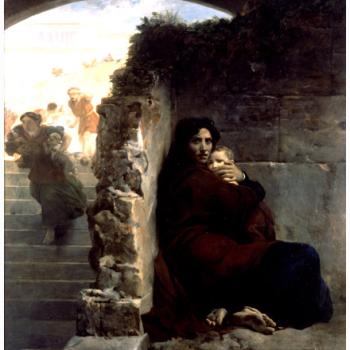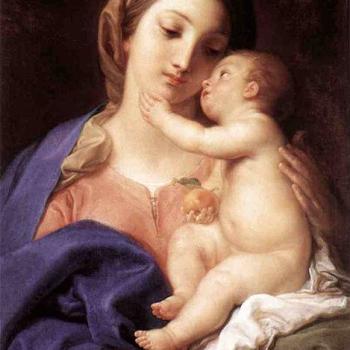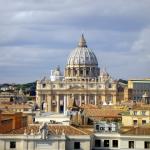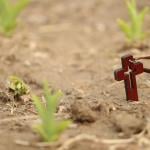Is a December 25th Birthdate of Jesus Impossible or Unlikely Because Sheep Can’t Take the Cold?
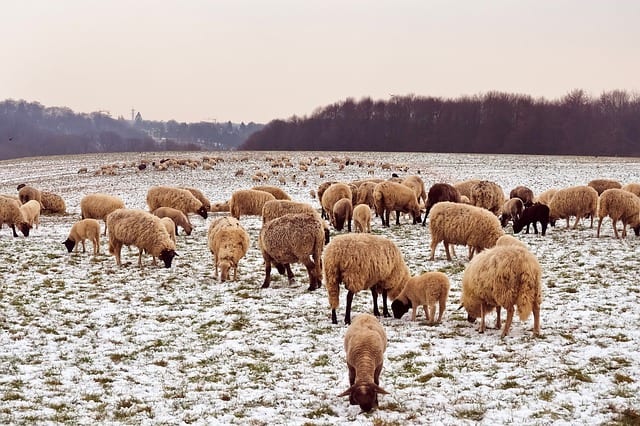
One common polemical argument against a December birthdate for Jesus is based on a skepticism towards the biblical passage Luke 2:8: “And in that region there were shepherds out in the field, keeping watch over their flock by night” (RSV). Atheists, biblical skeptics, and even serious observant Christians make the fallacious argument that it was too cold at that time of year in Bethlehem for sheep to graze, or shepherds to be in the field watching them. But this objection has no rational basis, and is in fact a fatally weak and desperate argument: as I will demonstrate.
I’ve already provided evidence in several papers of mine for the December 25th birth of Jesus, based on the Bible, historical argument, and astronomy:
December 25th Birth of Jesus?: Interesting Considerations [12-11-17]
Was Christ Actually Born Dec. 25? [National Catholic Register, 12-18-18]
Star of Bethlehem, Astronomy, Wise Men, & Josephus (Amazing Astronomically Verified Data in Relation to the Journey of the Wise Men & Jesus’ Birth & Infancy) [12-14-20]
Conjunctions, the Star of Bethlehem and Astronomy [National Catholic Register, 12-21-20]
This question, then, basically comes down to four things:
1) How much cold can sheep endure?
2) Can / do shepherds graze sheep in the winter?
3) What is the average temperature in Bethlehem in December?
4) Were / are sheep in fact kept outside in December in or near Bethlehem?
Let’s consider each factor in turn:
I. How much cold can sheep endure?
“Sheep are most comfortable at 45-70 degrees Fahrenheit. When temperatures dip below this level, we need to do everything we can to make sure lambs stay healthy and perform. . . . Adult sheep are capable of enduring the outdoors during the thick of winter, but lambs are not,” . . .
“Typically, in temperatures below 32 degrees Fahrenheit, lambs demand additional energy to maintain normal body temperature.” (“Cold weather 101: Help lambs beat the winter chill”, Farm & Ranch Guide, 11-13-18)
Thanks to their thick, woolly coats, sheep are a relatively easy animal to prepare for the coming winter months. . . .
…But Don’t Lock Them Up
You may be tempted to herd your sheep into an enclosed, covered area and leave them there to protect them from the low temperature. Allowing them to roam around outside (when dry) will allow them access to better ventilation and will also give them the means to exercise properly and stretch their legs. (“Winter Preparation – Sheep Care”, Tanner Trading)
Snow is no obstacle to grazing, and sheep, with their thick wool coats, aren’t bothered by even the coldest temperatures. The sheep will stay in the pasture, being moved to fresh paddocks daily just as in the warm weather growing season, until they run out of forage. (“winter grazing — sheep”, The One-Cow Revolution, 12-30-19)
Full fleeces also work well to keep sheep warm when temperatures drop below freezing, but if precipitation and windy conditions occur or temperatures drop below 0°F, even sheep with full fleece will undergo cold stress. (“Do Sheep and Goats get Cold?”, Erika Lyon, OSU Sheep Team, 1-30-18)
II. Can / do shepherds graze sheep in the winter?
Winter is here once again. In this article I would like to share what I have learned over the years when it comes to grazing in cold and freezing conditions and with snow on the ground.
Snow on the ground does not necessarily mean that the grazing season ends. Sheep have the ability to dig through the snow to get to the grass. It matters, though, what kind of snow it is. Light and fluffy snow can be as deep or deeper than a foot and there will be no problems for the sheep to dig through. In fact, they will do so with relatively little effort. Wet snow takes more of an effort. Drifted snow is even harder and at times impossible for the sheep to dig through even when there is less than a foot of snow on the ground. . . .
A word of caution when grazing sheep in the winter: While cold temperatures generally do not bother well-fed sheep in full fleece, cold winds do. One must be prepared to provide shelter on a moment’s notice if the weather changes. Check the weather report frequently. When it is cold and the wind starts hauling, I want to make sure that my sheep have the appropriate shelter. This does not necessarily mean that they need to be locked up in the barn. A thick hedgerow that breaks the wind can be used to provide the necessary animal comfort. (“Considerations for Winter Grazing Your Sheep”, Sarah Diana Nechamen, Cornell Small Farms Program, 1-12-15)
In Ohio it is possible to graze year round. Of course grazing in winter does take planning. Summer is the best time to plan for fall and winter grazing. Why? Because many of our options have tasks associated with them in summer. By planning ahead it is possible in Ohio to have adequate quality, grazable forage for most of the winter. (“Fall and Winter Grazing Strategies”, Dr. Jeff McCutcheon, OSU Sheep Team, 10-31-17)
III. What is the average temperature in Bethlehem in December?
The cool season lasts for 3.1 months, from December 5 to March 8, with an average daily high temperature below 60°F. The coldest day of the year is January 25, with an average low of 41°F and high of 53°F. . . . [the chart provided showed the average high on December 5th to be 60 degrees, and the average low 46 degrees]. (“Average Weather in Bethlehem”, Weather Spark)
December, the first month of the winter, in Bethlehem, is still a mild month, with average temperature fluctuating between 7°C (44.6°F) and 14°C (57.2°F). In December, the average high-temperature drops, from a pleasant 20°C (68°F) in November, to a mild 14°C (57.2°F). (“Monthly weather forecast and climate[:] Bethlehem, West Bank”, Weather Atlas)
The current temperature in Bethlehem, as I write (12-26-20), is 52 degrees, at 7:52 PM local time, with a forecast overnight low of 44. The low temperatures until the end of the year are forecast at 44, 48, 45, 45, and 47 (AccuWeather: Bethlehem, West Bank).
IV. Were / are sheep in fact kept outside in December in or near Bethlehem?
Years ago, in large volumes entitled Picturesque Palestine, the much-traveled Canon H. B. Tristram (died 1906), who had made frequent visits to Palestine, wrote as follows (Vol. I, page 124):
“A little knoll of olive trees surrounding a group of ruins marks the traditional site of the angels’ appearance to the shepherds, Migdol Eder, ‘the tower of the flock’. But the place where the first ‘Gloria in excelsis’ was sung was probably further east, where the bare hills of the wilderness begin, and a large tract is claimed by the Bethlehemites as a common pasturage. Here the sheep would be too far off to be led into the town at night; and exposed to the attacks of wild beasts from the eastern ravines, where the wolf and the jackal still prowl, and where of old the yet more formidable lion and bear had their covert, they needed the shepherds’ watchful care during the winter and spring months, when alone pasturage is to be found on these bleak uplands”. . . .
Here an authority of no mean standing tells us that in the dry summer season the hills are well-nigh bare, affording insufficient pasture, so the shepherds then normally keep their sheep near the town and enfold them at night. But when the winter rains fall, the hills become clothed with grass, and the shepherds, knowing this, take their sheep further a field. Then, because it would make the sheep walk too far to reach the folds every evening, expending energy needlessly, they simply watch their flocks in the fields all night. This seems to be precisely what the evangelist Luke describes:
“And there were in the same country shepherds abiding in the field, keeping watch over their flock by night” (Luke 2:8).
As far back as 1863, Smith’s Bible Dictionary, under the heading ‘Palestine: the Climate’, explained the rarity of snow in southern Palestine, while it conceded its more frequent occurrence in the northern parts of the land. The mean temperature at Jerusalem during December is said to run around 47 to 60 degrees F.
It certainly would not hurt sheep to be out at night in that sort of temperature. The Dictionary further states:
“As in the time of our Saviour (Luke 12: 54), the rains come chiefly from the S. or S.W. They commence at the end of October or beginning of November, and continue with greater or less constancy till the end of February or middle of March, and occasionally, though rarely, to the end of April. It is not a heavy continuous rain, so much as a succession of severe showers or storms with intervening periods of fine bright weather, permitting the grain crops to grow and ripen. And although the season is not divided by any entire cessation of rain for a lengthened interval, as some represent, yet there appears to be a diminution in the fall for a few weeks in December and January, after which it begins again, and continues during February and till the conclusion of the season.”
It may be noted that the traditional date for the birth of Christ falls in this period of the diminution of rainfall toward the end of December. The former rains would have produced grass on the hills, and the fine bright weather intervening between the rains, with temperatures averaging 55 degrees F. would be excellent for sheep grazing on the hills east of David’s royal city. (David J. Gibson, Bible League Quarterly, October/December 1965; reprinted as “The Date of Christ’s Birth”, Nabataea.Net)
That the Messiah was to be born in Bethlehem, was a settled conviction. Equally so was the belief, that He was to be revealed from Migdal Eder, ‘the tower of the flock.’ This Migdal Eder was not the watch-tower for the ordinary flocks which pastured on the barren sheep-ground beyond Bethlehem, but lay close to the town, on the road to Jerusalem. A passage in the Mishnah leads to the conclusion, that the flocks, which pastured there, were destined for Temple-sacrifices, and, accordingly, that the shepherds, who watched over them, were not ordinary shepherds. The latter were under the ban of Rabbinism, on account of their necessary isolation from religious ordinances, and their manner of life, which rendered strict legal observance unlikely, if not absolutely impossible. The same Mishnic passage also leads us to infer, that these flocks lay out all the year round, since they are spoken of as in the fields thirty days before the Passover—that is, in the month of February, when in Palestine the average rainfall is nearly greatest. Thus, Jewish tradition in some dim manner apprehended the first revelation of the Messiah from that Migdal Eder, where shepherds watched the Temple-flocks all the year round. (Alfred A. Edersheim, A., The Life and Times of Jesus the Messiah, Vol. 1, pp. 186–188; New York: Longmans, Green, and Co., 1896; see secondary source of the citation)
The Jewish historian Josephus writing in the first century records that during New Testament times at Passover up to 260,000 lambs would be sacrificed in the temple at Jerusalem. . . .
The lambs had to be no more than one year old, male and without spot or blemish. Therefore they had to be bred and born in controlled conditions and inspected for birth defects before being raised in a specially protected environment.
The other interesting detail is the Jewish regulations stipulated that any animal to be sacrificed at the Temple had to be born within five miles of Jerusalem.
Bethlehem is just five miles from Jerusalem. . . .
At the time of Jesus’ birth, therefore, the hillsides around Bethlehem, were a first century lamb factory farm controlled by the priestly livestock traders from the temple. When the lambs were born the shepherds wrapped them in strips of cloth to protect them, and placed them in a stone feeding trough in the birthing barn until the priest could come to inspect them.
By the way, some skeptics point out that the details don’t match with Jesus being born in the winter because lambs are born in the Spring. It’s true that lambs are born in the Spring in Northern Europe.
However, the breed of sheep most common in the Middle East– the Awassi – give birth in December.
So there, on the hills surrounding Bethlehem was a large farming community dedicated to the specialized task of breeding the huge number of lambs for the Passover sacrifice. Each December thousands of “Lambs of God” were born and set aside for the Spring sacrifice. (“The True Story of the Bethlehem Shepherds”, Fr. Dwight Longenecker, The Stream, 12-22-19)
William Hendriksen quotes a letter dated Jan. 16, 1967, received from the New Testament scholar Harry Mulder, then teaching in Beirut, in which the latter tells of being in Shepherd Field at Bethlehem on the just-passed Christmas Eve, and says: “Right near us a few flocks of sheep were nestled. Even the lambs were not lacking.” (Jack Finegan, Handbook of Biblical Chronology, 2nd ed., no. 569, quoting Hendriksen, New Testament Commentary: Matthew, Grand Rapids: Baker, 1973, 1:182)
V. Conclusion
Sheep (having wool coats) are easily able to endure even winter cold. And they are in fact grazed in the winter, even in very cold and snowy conditions (though there are some limits with ice preventing them from eating, etc.). The average low temperature in Bethlehem in December is about 46, according to two weather sources, with the average high, 57: scarcely even “winter conditions”: by American standards, and in no way prohibitive for sheep with wool coats.
The current (early evening) temperature in Bethlehem as I wrote this article (on 12-26-20) was 52 degrees. Both historical and current observational data show that sheep were and are in fact grazed in December near Bethlehem (historically it was primarily for the purposes of temple sacrifice, which occurred all year round on a daily basis).
Therefore, this particular polemical argument against a proposed birthdate of Jesus on December 25th fails miserably on all counts. In other words, if one argues that Jesus was not born on December 25th, these alleged reasons are definitely not any evidence for such a claim. Or, conversely: if we have good reasons to believe that He was born on December 25th, these particular arguments do not refute them at all.
***
Photo credit: MichaelGaida (2-3-19): sheep grazing in the winter [Pixabay / Pixabay License]
***





